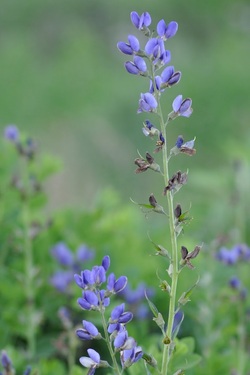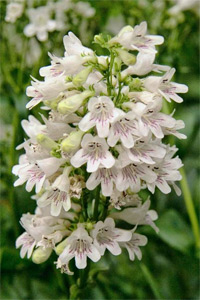What to look for in...
Early-SUMMER (MAY-JUNE)

A June stroll in the Snetsinger Butterfly Garden will delight park visitors with eyecatching plantings in blue and white.
Baptisia australis, commonly known as Blue false indigo, is native to most of the Eastern and Central United States. A member of the pea family, this bushy perennial forms tall spikes of beautiful blue-purple flowers, with lovely blue-green trifoliate leaves (composed of three leaflets). It is drought tolerant, long-lived, deer resistant, and not inclined to take over other plantings. Although the leaves die back to the ground each winter, Baptisia foliage is dense and attractive, it’s shrub–like appearance makes a lovely specimen plant or backdrop to the garden. Baptisia australis can be spotted in bloom at the garden’s edge in the Penn State Extension Master Gardener Pollinator Friendly Demonstration Garden.
The botanical name Baptisia originates from the Greek word bapto, to dip or to dye. Blue false indigo was once used to produce a blue dye by Native Americans and early settlers.
Baptisia is an important host for many butterflies observed in the Snetsinger Butterfly Garden, including the Wild Indigo Duskywing, Silver-Spotted Skipper, Eastern Tailed Blue, Clouded Sulphur, Little Sulphur, and Orange Sulphur.
Baptisia australis, commonly known as Blue false indigo, is native to most of the Eastern and Central United States. A member of the pea family, this bushy perennial forms tall spikes of beautiful blue-purple flowers, with lovely blue-green trifoliate leaves (composed of three leaflets). It is drought tolerant, long-lived, deer resistant, and not inclined to take over other plantings. Although the leaves die back to the ground each winter, Baptisia foliage is dense and attractive, it’s shrub–like appearance makes a lovely specimen plant or backdrop to the garden. Baptisia australis can be spotted in bloom at the garden’s edge in the Penn State Extension Master Gardener Pollinator Friendly Demonstration Garden.
The botanical name Baptisia originates from the Greek word bapto, to dip or to dye. Blue false indigo was once used to produce a blue dye by Native Americans and early settlers.
Baptisia is an important host for many butterflies observed in the Snetsinger Butterfly Garden, including the Wild Indigo Duskywing, Silver-Spotted Skipper, Eastern Tailed Blue, Clouded Sulphur, Little Sulphur, and Orange Sulphur.
|
Also in bloom, are several stands of Penstemon digitalis, commonly known as Tall or Foxglove beardtongue. The white tubular flowers attract many long-tongued bees, including bumblebees, miner bees, mason bees, and leaf-cutting bees. Sometimes there are fine lines of violet within the flower, which function as nectar guides to visiting insects. Penstemons are called beardtongues because the stamen has a tuft of small hairs. These hairs can lodge against the hairs of a visiting bee, and if the bee is large enough, the pollen will become deposited on the back of the insect.
This long blooming native perennial will bloom in full or partial sun, and adapts to many different soil conditions. |

